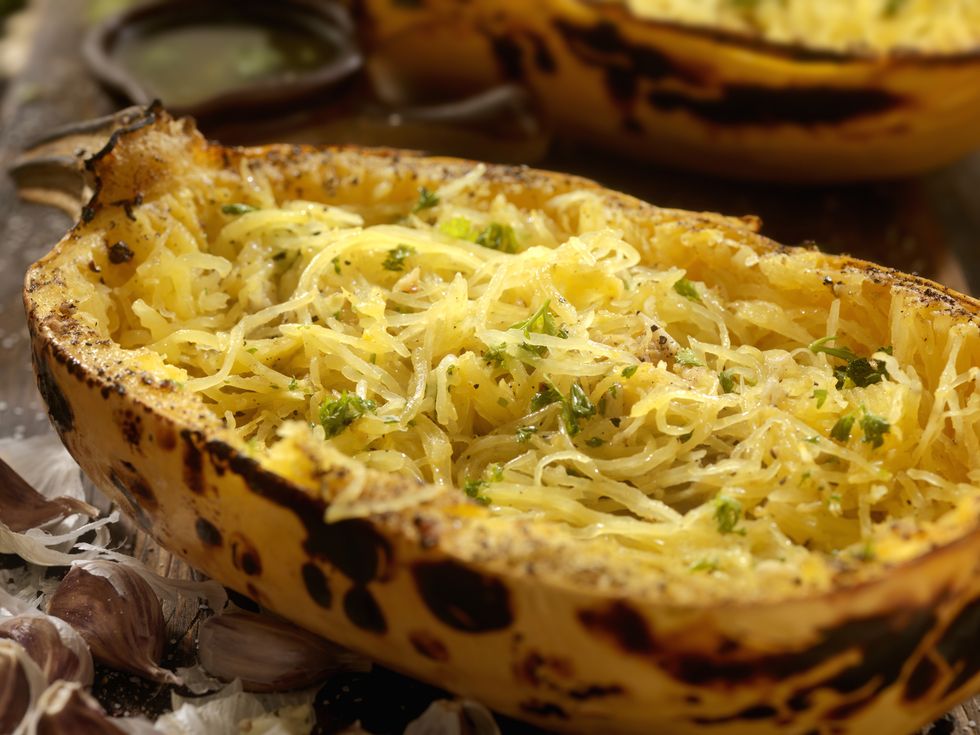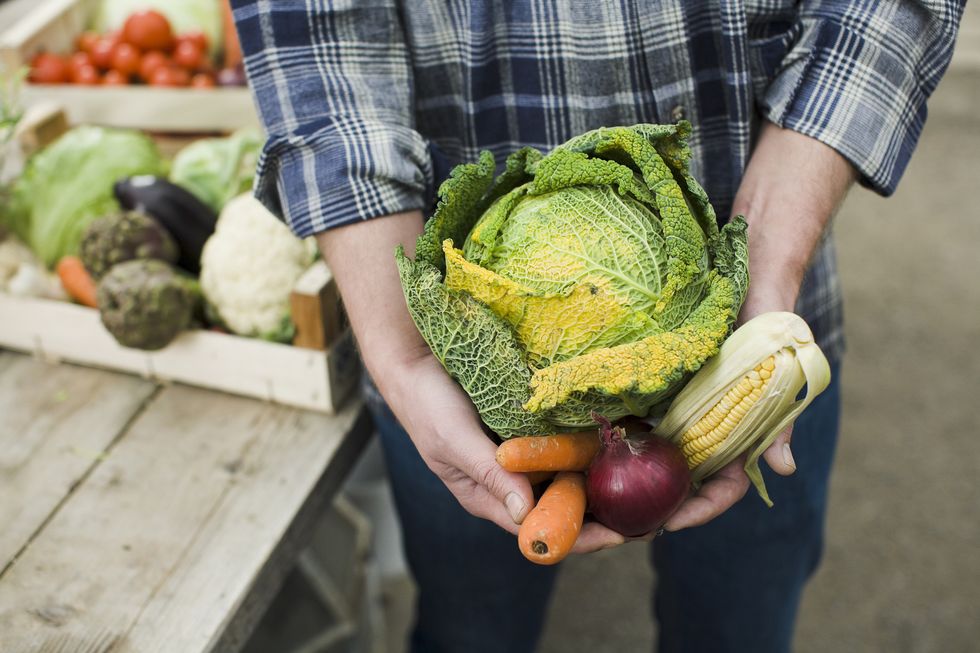YES, YOU should be eating your vegetables—for many, many reasons.
“Vegetables should be a staple of your diet because they are naturally packed with antioxidants, vitamins, and minerals, and are low in calories,” says Annelie Vogt von Heselholt, R.D., founder of DietitianDoc. “They also help prevent chronic diseases like heart disease and cancer.”
Vogt von Heselholt notes that a good goal is to fill half your plate with vegetables. “Put in another way, men should be upwards of three to four cups per day. One serving generally means one cup of raw or cooked vegetables or two cups raw green leafy greens.”
So are vegetables such a boon for weight loss?
Absolutely—and one of the key reasons is fiber.
“Vegetables of nearly all varieties can help with weight loss due to their high fiber content, which keeps us feeling fuller longer, their antioxidant content, which is very high and anti-inflammatory, and their high-water content, which makes them low calorie and incredibly healthy, but still filling,” says Dana Ellis Hunnes, Ph.D., M.P.H., R.D., senior clinical dietitian at UCLA Medical Center and assistant professor at UCLA Fielding School of Public Health. “You can never go wrong in weight loss, or maintenance, by adding more vegetables to your diet.”
Ellis Hunnes highlights that dietary guidelines recommend five to nine servings of fruits and vegetables daily. (See more on that breakdown here.)
“Vegetables are naturally very low in calories and fat which means that you can eat a lot of them without gaining weight. A cup of vegetables only has between 20 and 50 calories while a cup of pasta or rice has about 200 calories. If you substitute high-calorie foods for vegetables, you can easily and safely control your weight,” says Vogt von Heselholt, who says that vegetables are also high in water and fiber.
“Fiber provides volume which keeps you feeling full longer while helping to suppress your appetite. Fiber also helps prevent changes in energy levels and blood sugars which leads to less fat being stored,” she says. “While fiber doesn’t provide calories, bacteria in the gut can feed on it and that could potentially affect weight loss. As a result, fiber helps you feel satisfied longer which makes you naturally eat less and lose weight. Vegetables also take longer to chew and eat which means that you generally eat less.”
Barbara Kovalenko, R.D., nutrition consultant in Lasta Fasting says “Incorporating healthy vegetables into your daily diet is crucial for overall well-being and weight loss.”
Kovalenko says to aim for at least five servings of vegetables per day due to the fact they’re packed with essential nutrients, fiber, and are low in calories.
Robert Iafelice, M.S., R.D.N., nutrition expert at SETFORSET says people should eat about 2 ½ servings of dark green and colorful (think rainbow) vegetables each day. As Iafelice explains, the micronutrients in veggies include the important antioxidants – vitamin C, vitamin E, and beta-carotene (provitamin A)—and essential minerals such as zinc, chromium, and selenium.
Plus, they’re fiber rich: “The fiber in veggies includes both soluble and insoluble fiber. Soluble fiber (e.g., broccoli, Brussels sprouts) helps with blood sugar and blood cholesterol regulation. Insoluble fiber (e.g., carrots, potatoes) help more with peristalsis—the movement of food through the gut,” he says. Translation? Veggies help “you stay regular,” a veritable blessing as all who have endured constipation know.
Want to reap the benefits of vegetables in your diet? Check out these 11 amazing vegetables to eat if you want to drop weight.
Onions
“Onions are one of the best prebiotic veggies. Prebiotics improve the composition and the diversity of the gut microbiota. More and more research is suggesting that an unhealthy microbiota favor weight gain,” says Iafelice.
Chile Peppers
Along with being a rich source of vitamin C and various trace minerals, shares Iafelice, chili peppers also contain capsaicin. “Capsaicin increases energy expenditure by triggering the burning of brown fat via thermogenesis (the production of heat). It also regulates appetite and satiety.”
And if you’re not a fan of extreme heat, mild chili peppers are a great option to sprinkle into salsa or salads. Whether you go for hot or mild chili peppers, other recipe ideas include roasting them, grilling them, pan-searing them, or adding them to eggs, sandwiches, or burgers.
Asparagus
Asparagus is low in calories and high in both soluble and insoluble fiber, says Iafelice. Asparagus also contains asparagine (after which it was named). Asparagine is a non-essential amino acid that promotes thermogenesis in brown fat. Brown fat increases energy expenditure by breaking down fat to create heat.” Translation: Eat more asparagus, folks. Put asparagus in a frittata or “try grilling asparagus or just eating it as a salad with vinaigrette dressing,” says Iafelice.
Spinach
“This leafy green vegetable is rich in vitamins, minerals, and antioxidants, while being incredibly low in calories,” says Kovalenko, adding that its high fiber content aids in digestion and helps control hunger. “Spinach also contains thylakoids, compounds that have been found to reduce cravings and promote feelings of fullness.”
If you’re a smoothie guy, toss a handful of frozen spinach (it tends to be more affordable than buying it fresh) into your favorite recipe or try The Green Beast Power Shake.
Bell Peppers
Kovalenko cites bell peppers as another weight-loss friendly vegetable, highlighting them for being low in calories and rich in vitamins A, C, and E, as well as antioxidants. Plus, if you’re a potato chip or pretzel aficionado, you may find the “satisfying crunch” of bell peppers a nice replacement for a less healthy choice. Kovalenko also suggests incorporating bell peppers into salads, stir-fries, or roasted vegetable dishes.
“They can also be stuffed with lean protein and other veggies for a nutritious and delicious meal option,” she adds.
Arugula
If you’re hoping to see the number on the scale go down, add this dark leafy green into salads, pasta, and even smoothies pronto.
“[Arugula] is a green that is filled with flavor. It’s spicy and makes a very delicious and interesting salad base. It’s filled with fiber, folic acid, vitamin K, other vitamins and minerals,” says Ellis Hunnes. She adds that arugula helps with weight loss because it’s very low in calories but high in fiber, taking a while to eat and so it reduces the overall calories eaten during a particular meal.
Broccoli
Is there any better healthy, crunchy snack than a few broccoli stalks cut up with a little bit of salt sprinkled on top?
“Broccoli is low in calories, and high in water, fiber, and vitamin C, which may all help weight loss. Vitamin C, in particular, is showing some promise as a weight loss aid,” says Vogt von Heselholt. “Researchers believe that it’s the anti-oxidative and anti-inflammatory properties of vitamin C that may provide the positive effects.”
Cauliflower
Cauliflower is another cruciferous vegetable for your consideration.
“Besides being low in calories yet high in water, fiber, and antioxidants, cauliflower is very versatile. It can be baked, roasted, or used fresh or frozen in smoothies, soups, and stews. By substituting a regular pizza crust, white rice, or mac and cheese for cauliflower, you could save upwards of 400 calories,” says Vogt von Heselholt.
She adds,“Cauliflower has also been shown to be inversely associated with weight, meaning, the higher the intake, the lower the weight. Researchers attribute this association to the high fiber content and its influence on appetite, fullness, glucose and insulin responses, and fat storage.”
Spaghetti Squash
As Vogt von Heselholt explains, spaghetti squash is low in calories, high in water, fiber, and antioxidants—just like cauliflower.
“It’s also a great substitute in pasta dishes, gratins, and casseroles—and it may help promote weight loss. The fiber in spaghetti squash slows the emptying of the stomach that can help reduce hunger and appetite,” she says.
Jicama
For a hefty dose of fiber and vitamin C, stop overlooking this Central American staple. Jicama is native to Mexico and can be enjoyed raw or cooked—like in baked “jicama fries” format.
“Jicama is a deliciously delicately flavored but crunchy root vegetable that is low in calories, high in fiber, and high in water,” says Ellis Hunnes. “It takes up volume in your stomach without adding many calories, which can lower overall calorie intake for that meal per day and promote weight loss.”
Cabbage
Whether you sauté cabbage in oil and a little sherry vinegar for a healthy side dish or use it as a base for a salad, incorporate this slimming vegetable into your diet as much as possible.
“Cabbage is low in calories and high in fiber which helps keep you feeling full without all the calories,” says Vogt von Heselholt. “Cabbage is believed to promote weight loss by balancing glucose, limiting oxidative stress, inflammation, and resistance to insulin seen with diabetes.”
Zucchini
Whether you opt for zucchini or other summer squash, add this vegetable to your grocery cart regularly.
“Zucchini is another vegetable that is filled with water and fiber while remaining low in calories,” says Ellis Hunnes. “It can be grilled, baked, broiled, sautéed, and take on any flavor of the food.” Ellis Hunnes emphasizes that like other veggies, zucchini adds bulk to a meal without adding many calories—and it’s all thanks to fiber.
Perri is a New York City-born and -based writer; she holds a bachelor’s in psychology from Columbia University and is also a culinary school graduate of the plant-based Natural Gourmet Institute, which is now the Natural Gourmet Center at the Institute of Culinary Education. Her work has appeared in the New York Post, Men’s Journal, Rolling Stone, Oprah Daily, Insider.com, Architectural Digest, Southern Living, and more. She’s probably seen Dave Matthews Band in your hometown, and she’ll never turn down a bloody mary. Learn more at VeganWhenSober.com.






Comments are closed.